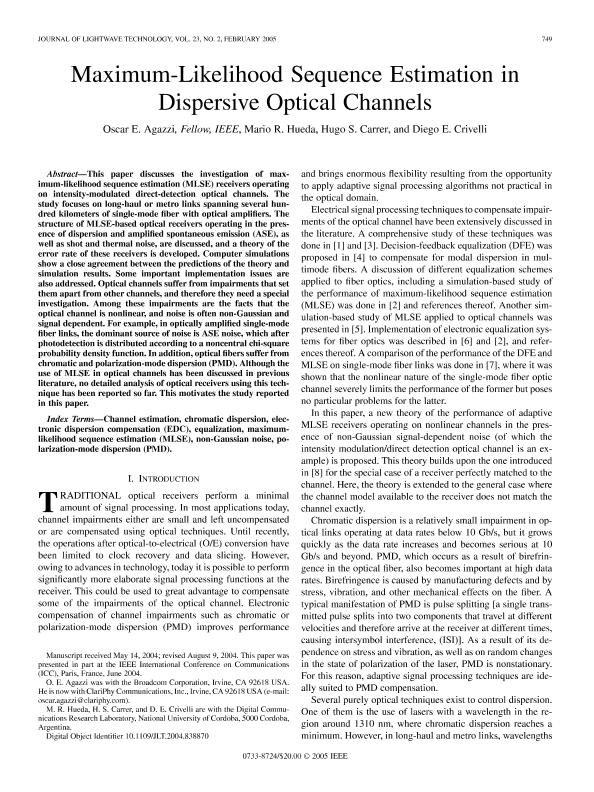Mostrar el registro sencillo del ítem
dc.contributor.author
Agazzi, Oscar Ernesto

dc.contributor.author
Hueda, Mario Rafael

dc.contributor.author
Carrer, Hugo Santiago

dc.contributor.author
Crivelli, Diego Ernesto

dc.date.available
2020-10-08T19:02:17Z
dc.date.issued
2005-02
dc.identifier.citation
Agazzi, Oscar Ernesto; Hueda, Mario Rafael; Carrer, Hugo Santiago; Crivelli, Diego Ernesto; Maximum-likelihood sequence estimation in dispersive optical channels; Institute of Electrical and Electronics Engineers; Journal Of Lightwave Technology; 23; 2; 2-2005; 749-763
dc.identifier.issn
0733-8724
dc.identifier.uri
http://hdl.handle.net/11336/115629
dc.description.abstract
This paper discusses the investigation of maximum-likelihood sequence estimation (MLSE) receivers operating on intensity-modulated direct-detection optical channels. The study focuses on long-haul or metro links spanning several hundred kilometers of single-mode fiber with optical amplifiers. The structure of MLSE-based optical receivers operating in the presence of dispersion and amplified spontaneous emission (ASE), as well as shot and thermal noise, are discussed, and a theory of the error rate of these receivers is developed. Computer simulations show a close agreement between the predictions of the theory and simulation results. Some important implementation issues are also addressed. Optical channels suffer from impairments that set them apart from other channels, and therefore they need a special investigation. Among these impairments are the facts that the optical channel is nonlinear, and noise is often non-Gaussian and signal dependent. For example, in optically amplified single-mode fiber links, the dominant source of noise is ASE noise, which after photodetection is distributed according to a noncentral chi-square probability density function. In addition, optical fibers suffer from chromatic and polarization-mode dispersion (PMD). Although the use of MLSE in optical channels has been discussed in previous literature, no detailed analysis of optical receivers using this technique has been reported so far. This motivates the study reported in this paper.
dc.format
application/pdf
dc.language.iso
eng
dc.publisher
Institute of Electrical and Electronics Engineers

dc.rights
info:eu-repo/semantics/openAccess
dc.rights.uri
https://creativecommons.org/licenses/by-nc-sa/2.5/ar/
dc.subject
CHANNEL ESTIMATION
dc.subject
CHROMATIC DISPERSION
dc.subject
ELECTRONIC DISPERSION COMPENSATION (EDC)
dc.subject
EQUALIZATION
dc.subject
MAXIMUM-LIKELIHOOD SEQUENCE ESTIMATION (MLSE)
dc.subject
NON-GAUSSIAN NOISE
dc.subject
POLARIZATION-MODE DISPERSION (PMD)
dc.subject.classification
Ingeniería de Sistemas y Comunicaciones

dc.subject.classification
Ingeniería Eléctrica, Ingeniería Electrónica e Ingeniería de la Información

dc.subject.classification
INGENIERÍAS Y TECNOLOGÍAS

dc.title
Maximum-likelihood sequence estimation in dispersive optical channels
dc.type
info:eu-repo/semantics/article
dc.type
info:ar-repo/semantics/artículo
dc.type
info:eu-repo/semantics/publishedVersion
dc.date.updated
2020-10-06T17:57:30Z
dc.identifier.eissn
1558-2213
dc.journal.volume
23
dc.journal.number
2
dc.journal.pagination
749-763
dc.journal.pais
Estados Unidos

dc.journal.ciudad
New Jersey
dc.description.fil
Fil: Agazzi, Oscar Ernesto. Broadcom Corporation; Estados Unidos. ClariPhy Communications; Estados Unidos
dc.description.fil
Fil: Hueda, Mario Rafael. Consejo Nacional de Investigaciones Científicas y Técnicas. Centro Científico Tecnológico Conicet - Córdoba. Instituto de Estudios Avanzados en Ingeniería y Tecnología. Universidad Nacional de Córdoba. Facultad de Ciencias Exactas Físicas y Naturales. Instituto de Estudios Avanzados en Ingeniería y Tecnología; Argentina
dc.description.fil
Fil: Carrer, Hugo Santiago. Universidad Nacional de Córdoba. Facultad de Cs.exactas Físicas y Naturales. Departamento de Electronica. Laboratorio de Comunicaciones; Argentina
dc.description.fil
Fil: Crivelli, Diego Ernesto. Universidad Nacional de Córdoba. Facultad de Cs.exactas Físicas y Naturales. Departamento de Electronica. Laboratorio de Comunicaciones; Argentina. Consejo Nacional de Investigaciones Científicas y Técnicas; Argentina
dc.journal.title
Journal Of Lightwave Technology

dc.relation.alternativeid
info:eu-repo/semantics/altIdentifier/doi/http://dx.doi.org/10.1109/JLT.2004.838870
Archivos asociados
